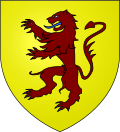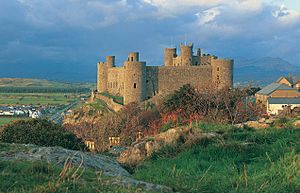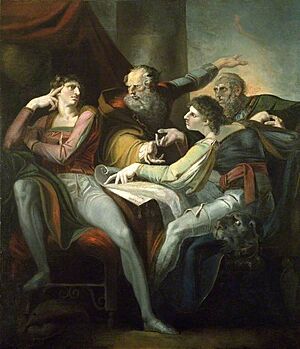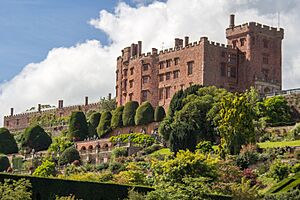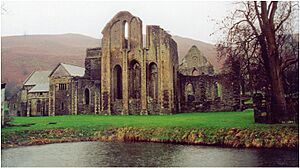House of Mathrafal facts for kids
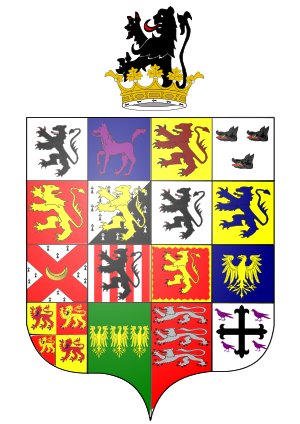
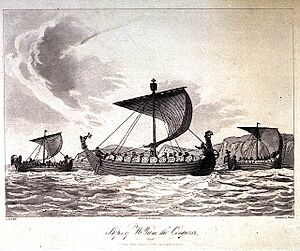
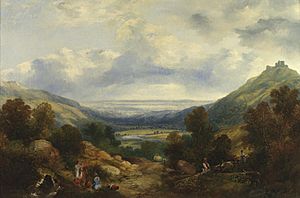
The Royal House of Mathrafal was an important family in Wales. It started as a younger branch of the House of Dinefwr, another Welsh royal family. They got their name from Mathrafal Castle, which was their main home and capital city. This family took over from the House of Gwertherion, who had ruled the Kingdom of Powys since Roman times.
The Mathrafal family became powerful after an ancestor, Merfyn the Oppressor, made a smart marriage. King Bleddyn ap Cynfyn, a founder of the Mathrafal family, joined the fight against William the Conqueror when he invaded England in 1066. After this, the Mathrafal family often struggled with the Plantagenet kings of England and other Welsh royal families to control Wales. Even though their power changed over time, they are best known as the Kings of Powys and the last native Prince of Wales.
Contents
History of the Mathrafal Family
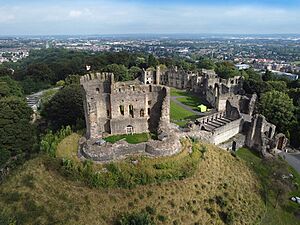
The House of Mathrafal became strong after the English King Harold Godwinson and his brother attacked the Welsh King Gruffydd ap Llywelyn in 1062–1063. After these attacks, Bleddyn ap Cynfyn was made King of Powys and Gwynedd. His main base was Mathrafal Castle, close to the English border. This castle became the family's capital in Powys, replacing the old Roman city of Viroconium.
From this time on, the Mathrafal family competed with the Royal House of Dinefwr and the Royal House of Aberffraw for control of Wales. Other Welsh kingdoms, like Gwent and Morgannwg, were quickly taken over by English lords called Marcher Lords after the Norman Conquest.
The Mathrafal family was most powerful between 1063 and 1081. But then they lost control of Gwynedd to the Aberffraw family after the Battle of Mynydd Carn. By 1191, the Kingdom of Powys was split into two parts: Powys Fadog in the north and Powys Wenwynwyn in the south. Powys Fadog became a loyal follower of Gwynedd, while Powys Wenwynwyn often competed with it.
Historian John Davies noted that after Powys was divided, the Mathrafal family was not as powerful as the Royal House of Aberffraw or the Royal House of Dinefwr. Mathrafal Castle was completely destroyed in 1212. After this, the Mathrafal family relied on English support to survive.
However, the Mathrafal family still had some influence. They even went against the Prince of Wales, Llywelyn ap Gruffudd, and helped the English King Edward Longshanks during his conquest of Wales in 1282–83. Because of this, they avoided being wiped out like other Welsh royal families. They even gave up their claims to be royalty in exchange for an English Lordship in 1283.
The Mathrafal family's power decreased in the early 1300s. But they became important again in the 1400s during the Welsh Revolt. This revolt was led by Owain Glyndŵr, who was a Prince of Wales. He fought against King Henry IV of England and Prince Henry of the House of Lancaster. Glyndŵr had connections to the Mathrafal, Dinefwr, and House of Aberffraw families.
The Welsh Revolt
The Welsh Revolt was supported by the French Royal House of Valois. It aimed to make Wales independent and even divide England among their relatives, the House of Percy and the Mortimer families. Although Owain Glyndŵr was crowned Owain IV of Wales in 1404 and took control of all Wales, he eventually lost the war to the English forces. He even created the first Welsh parliament at Harlech Castle.
Despite their loss, their efforts were not in vain. Their rebellion helped lead to the first Welsh Kings of England, the Royal House of Tudor. The Tudors were cousins of the Mathrafal family through their mother's side, the Tudors of Penmynydd. Members of this family, like Sir Owen Tudor, fought in the rebellions. Glyndŵr was the richest Welshman in Wales before his defeat in 1415. He captured many of King Edward Longshanks's main castles, including Conwy, Harlech, and Beaumaris. He also attacked Caernarfon.
This historical period was later made famous by William Shakespeare in his plays Henry IV, Part 1 and Part 2. The character "Owen Glendower" is featured in these plays. The plays show the wars between his family and Prince Hal (who became King Henry V). Other characters include his daughter, Lady Mortimer, and his son-in-law, Sir Edmund Mortimer.
Family Succession
The Mathrafal family line continued through the descendants of Prince Owain Glyndŵr and his brother, Lord Tudur ap Gruffudd. Today, their family is represented by branches like the House of Yale and the Rogers of Bryntangor. These families also represent the royal lines of North Wales and South Wales. Their family histories can be traced back to the Roman-British ruler Cunedda.
The Vaughans, Yales, and Hughes of Gwerclas families are also connected to the FitzGerald Dynasty and are direct descendants of the Plantagenets. Their ancestor, Lord Gerald de Windsor, was an Anglo-Norman. He was the son of the first governor of Windsor Castle for William the Conqueror. He married a Welsh princess named Nesta, who was the daughter of King Rhys ap Tewdwr of the House of Dinefwr.
The Wynn baronets, now represented by the Williams-Wynns, are related to Mathrafal through the princes of Aberffraw. A descendant, Mary Wynn, married Robert Bertie, and the Wynnstay Estate passed to her cousin.
Important Members of the Mathrafal Family
Here are some important members of the Mathrafal family:
- Bleddyn ap Cynfyn (King of Powys and Gwynedd): He helped the Anglo-Saxons fight against William the Conqueror.
- Gruffydd ap Llywelyn (King of Wales): He made an agreement with King Edward the Confessor. His widow later married King Harold Godwinson, who died fighting William the Conqueror.
- Rhiwallon ap Cynfyn (King of Powys and Gwynedd): His daughter married the King of Deheubarth.
- Trahaearn ap Caradog (King of Gwynedd): He fought against other Welsh kings and Norman lords.
- Rhiryd ap Bleddyn (King of Powys): He was killed in a war by the King of South Wales.
- Cadwgan ap Bleddyn (Prince of Powys): He was an ally of King Gruffudd ap Cynan.
- Owain ap Cadwgan (Prince of Powys): He was known for taking Princess Nest, the wife of Gerald de Windsor.
- Iorwerth ap Bleddyn (Prince of Powys): He joined rebellions but later betrayed his allies.
- Maredudd ap Bleddyn (Prince, later King of Powys): He made peace with King Henry I of England.
- Gruffydd Fychan ap Iorwerth (Marcher Lord): He was a Knight of Rhodes and fought in the Crusades.
- Gwladys ferch Rhiwallon (Queen of Deheubarth): She was the mother of Princess Nesta, who had a son with King Henry I of England.
Last Princes of Powys
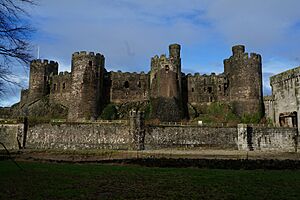
- Madog ap Maredudd (Prince of Powys): He fought for Empress Matilda against King Stephen of Blois of England.
- Gruffydd Maelor I (Prince of Powys Fadog): He was Lord of Yale and married Princess Angharad, daughter of the first Prince of Wales.
- Madog ap Gruffydd Maelor (Prince of Powys Fadog): He built the Valle Crucis Abbey and was an ally of King John Plantagenet.
- Owain Fychan (Lord of Mechain Is Coed): He captured and lost Carreghofa Castle multiple times.
- Owain Brogyntyn (Lord of Edeirnion): He was confirmed as a Baron by King Edward Longshanks.
- Marared ferch Madog: She was the mother of Llywelyn the Great, Prince of North Wales.
- Efa ferch Madog: She married the Prince of Maelienydd.
- Gwenllian ferch Madog: She was an ancestor of the Tudors and married Lord Rhys, Prince of Wales.
- Gwenwynwyn ab Owain Cyfeiliog (Ruler of Mid Wales): He made an agreement with King Richard the Lionheart.
- Gruffydd ap Gwenwynwyn (Prince of Powys Wenwynwyn): He married Hawise, whose father joined the Third Crusade.
- Owen de la Pole (Lord of Powys): His family lost their principality to King Edward Longshanks.
- Hawys Gadarn: She was the mother of Lord Charlton.
- Griffith de la Pole (Lord of Powys): He was the uncle of Lord Charlton.
- John Charlton, 3rd Baron Charlton: His family included powerful dukes.
- Gruffudd Fychan I (Prince of Powys Faddog): He was the great-grandfather of Prince Owain Glyndŵr.
- Gruffudd Fychan II (Prince of Powys Fadog): He married a great-granddaughter of Eleanor Plantagenet, King Edward I's daughter.
- Eleanor ap Thomas: She was the wife of Prince Gruffudd Fychan II.
- Owain Glyndŵr (Prince of Wales): He started the Welsh Revolt and was the richest Welshman in Wales.
- Tudor Glendower (Lord of Gwyddelwern): He was Owain Glyndŵr's brother and fought in the Welsh Revolt.
- Lowry ap Gruffudd: She was Owain Glyndŵr's sister. Her son held Denbigh Castle for his cousin during the Wars of the Roses.
- John Charlton, 4th Baron Charlton: His family included important duchesses.
- Edward Charlton, 5th Baron Charlton: He married Alianore Holland, who was related to King Richard II.
- Maredudd ab Owain Glyndŵr (Son of Owain Glyndŵr): He fought in the Welsh Revolt and was later pardoned by King Henry V of England.
- Catrin ferch Owain Glyndŵr: She married Sir Edmund Mortimer, who was related to many English kings.
- Lowrie ap Tudur: She inherited the family's royal claims and married Griffith ap Einion of the Fitzgerald dynasty.
- Elissau ap Gruffudd (Ellis ap Griffith): He was the founder of the House of Yale and an ancestor of Elihu Yale, who helped create Yale University.


